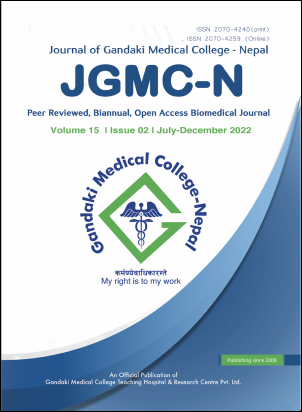Assessment of open surgical outcome of patients with lower limb varicose vein disease at a tertiary care center of Eastern Nepal
DOI:
https://doi.org/10.3126/jgmcn.v15i2.48939Keywords:
Greater Saphenous Vein, Flush Ligation and Stripping, Short Saphenous Vein, Venous Insufficiency, Varicose VeinAbstract
Introduction: The trend of varicose vein disease seems to be rising globally and its treatment options and outcome vary from the institution by institution. Management of the disease has also changed from high ligation, stripping, avulsion, and sclerotherapy to minimally invasive endovenous thermal ablation.
Methods: A retrospective observational study was carried out to find out the treatment methods and outcome of lower limb varicose vein disease at the cardiothoracic vascular surgery unit of the surgery department of B.P. Koirala Institute of Health Science from February 2019 to February 2020. The medical record of the patients was studied, relevant data entered and analyzed in statistical package for social sciences statistical software.
Results: Total registered patient during the study period were 46; which included 29(63%) male and 17(37%) female with mean age 38.41±10.12. Saphenous femoral junction reflux was seen in 38(82.60%) cases, saphenous popliteal junction reflux was seen in nine (19.60%) cases while perforator reflux was seen in 37(80.40%) cases. Saphenous femoral junction ligation, saphenous popliteal junction ligation was performed in 36(78.30%) and 7(15.20%) cases respectively. Stripping of the greater saphenous vein was done in 35(76.10%) cases, and 9(19.60%) cases were managed conservatively. Only 5(10.90%) cases developed infection, and none of the cases were found with recurrence or nerve injury. All the cases remained satisfied during the management course.
Conclusions: Saphenous femoral junction reflux was seen common and saphenous femoral junction ligation was performed on majority of the cases. Only 10% cases developed infection and all patients were satisfied during management course. Early surgical management of the disease overcomes complications and improves in the quality of life of the patients.
Downloads
Downloads
Published
How to Cite
Issue
Section
License
Copyright (c) 2022 Bijay Sah, Lokesh Shekhar Jaiswal, Rakesh Kumar Gupta

This work is licensed under a Creative Commons Attribution-NonCommercial 4.0 International License.
This license allows reusers to distribute, remix, adapt, and build upon the material in any medium or format for noncommercial purposes only, and only so long as attribution is given to the creator.




